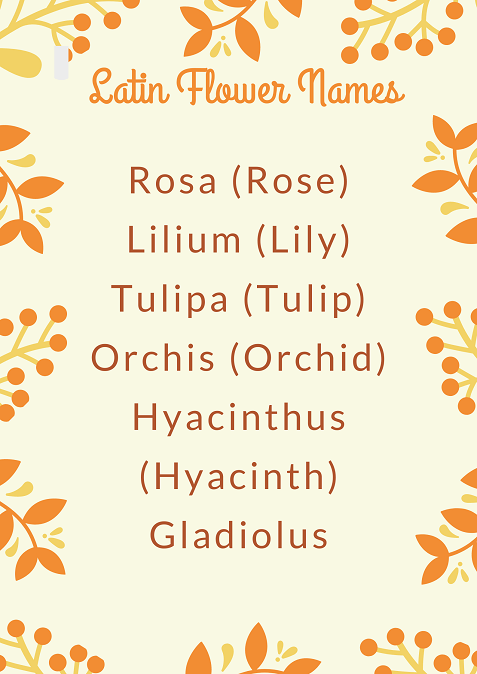30 Famous Latin Flower Names List – NamesBuddy
Are you looking for Latin flower names? If yes, you are in the best place to receive a list of them. Almost, every flower name has a Latin variation and they are extremely comparable to the scientific name.
When I started writing this post, I have come to know that many flower names are inspired by Greek and Latin terms.
But only some flowers have Latin variant names and I made sure to integrate all the notable flowers Latin names. I hope you love this post, let’s get started.
Cool Latin Flower Names
Rosa (Rose): Roses are one of the most popular flowers in the world. The word rose comes from the Latin word rosa, which means either “a flower” or “dew” (from ros, dew).
Lilium (Lily): The lily flower is a beautiful and delicate flower and belongs to the genus Lilium, which includes 17 species including the tiger lily, Asiatic lilies, Japanese showy lilies, and Turk’s turban lilies.
Tulipa (Tulip): Tulips are a perennial from the lily family. They have been cultivated as garden flowers since the 16th century, in addition to being used as garden flowers, tulips lend themselves well to cut flowers.
Orchis (Orchid): The orchid is a beautiful flower with more than 20,000 species. There are two categories of orchid flowers: terrestrial ones and epiphytic ones. The terrestrial orchids grow in the ground while the epiphytic ones grow on trees.
Hyacinthus (Hyacinth): Hyacinth flowers are a symbol of early spring and innocence. The flower was named after the Greek god Hyacinthus.
Gladiolus: It’s the diminutive of the Latin word gladius which means sword and the Gladiolus flower is native to South Africa. The flower is typically blue, purple, or white.
Anemone: Anemones are in the buttercup family and grow in large clusters, the flowers are usually orange, pink, or white with a yellow or blue center.
Narcissus (Daffodil): Daffodils are one of the most popular flowers in the world. Daffodils are common in many areas of the world. Their bright colors and cheerful appearance have made them a favorite for many gardeners.
Papaver (Poppy): The poppy flower is one of the most popular flowers in the world. They are grown all over Europe, Asia, North America, and Australia.
Helianthus (Sunflower): Sunflowers are a type of plant that has large, yellow, circular petals. Sunflowers are known for their cheerful yellow color and large flowers. It is also common knowledge that sunflower seeds are edible and easy to harvest.
Hyacinthoides (Bluebell): The Bluebell flower is a member of the lily family and the bell-shaped flowers are white or pale purple, and may occasionally be tinged with pink.
Cerasus Flores (Cherry blossom): Cherry blossom is a beautiful flower that can be found in Japan and other Asian countries.
Paeonia (Peony): Peonies are a type of flower that blooms in the late spring. They are available in white, pink, lavender, red, and yellow.
Gaillardia (Blanket flower): The blanket flower is a low-growing perennial that blooms with large yellow petals and an interesting seed head. Blanket flower is most commonly found in prairies.
Lotos (Lotus): The lotus flower is a symbol of purity in many cultures, and this beauty has long been considered the most graceful of water plants. Its aroma is sweet and its seeds are used in cooking.
Taraxacum officinale (Dandelion): Dandelion flowers are known for their jagged edges and yellow petals. However, dandelions can grow in a variety of colors such as purple, white, and more. They are also edible.
Primula (Daisy): It is one of the most popular garden flowers, grown worldwide. The flowers are usually yellow, but there are also white, pink, and purple varieties.
Crocus: Crocus is a genus of flowering plants in the iris family Iridaceae. Crocuses bloom in late winter or early spring before the leaves appear.
Lobelia (Cardinal flower): The cardinal flower is native to North America, and can be found in the wild from Canada to Mexico. It has striking flowers that are red with a white spot in the middle, which resembles a cardinal’s head.
Aster: Aster flowers are part of the Asteraceae family and are native to many parts of the world.
Amsonia (Blue star): Blue Star is a perennial plant with a gorgeous blue star-shaped flower. Blue Star Flower is native to North America.
Gardenia: Gardenia is a flowering shrub that originated in Asia. It’s native to the Southern regions of China, Japan, Taiwan, and Korea. Gardenias are also grown in Central America and Florida.
Tagetes (Marigold): Marigolds are a type of flower known for being brightly colored and typically yellow. They are part of the daisy family and have been used as both a food source and as a medicinal herb for centuries.
Salvare (Salvia): Salvia derived from the Latin word salvare.
Hippeastrum (Amaryllis): Amaryllis flowers are one of the most popular flowers in the world and belong to the family Amaryllidaceae.
Vinca Minor (Myrtle): The Myrtle flower is an evergreen shrub and it blooms in the late spring. It has a sweet, fragrant scent and the leaves are very fragrant too.
Ros Marinus (Rosemary): Rosemary is a herb used as both a spice and medicinal plant. It is attributed to the ability to improve memory, increase hair growth, and prevent baldness.
Viola (Pansy): A pansy is a colorful flowering plant. In the United States, it is often called a “viola”. It belongs to the Violaceae family. Pansies are grown for their ornamental flowers and can be found in many colors and varieties.
Campanula (Bellflower): Bellflowers are a large genus of plants that usually produce blue, bell-shaped flowers. They’re most commonly found in North America and Europe.
Iris: Iris flowers are one of the most beautiful flowers in the world. They are part of the Iridaceae family and come in a variety of colors, shapes, and sizes.
ALSO READ: Flower Nicknames

That’s all for now. I hope you have liked the post. Thanks for visiting.







